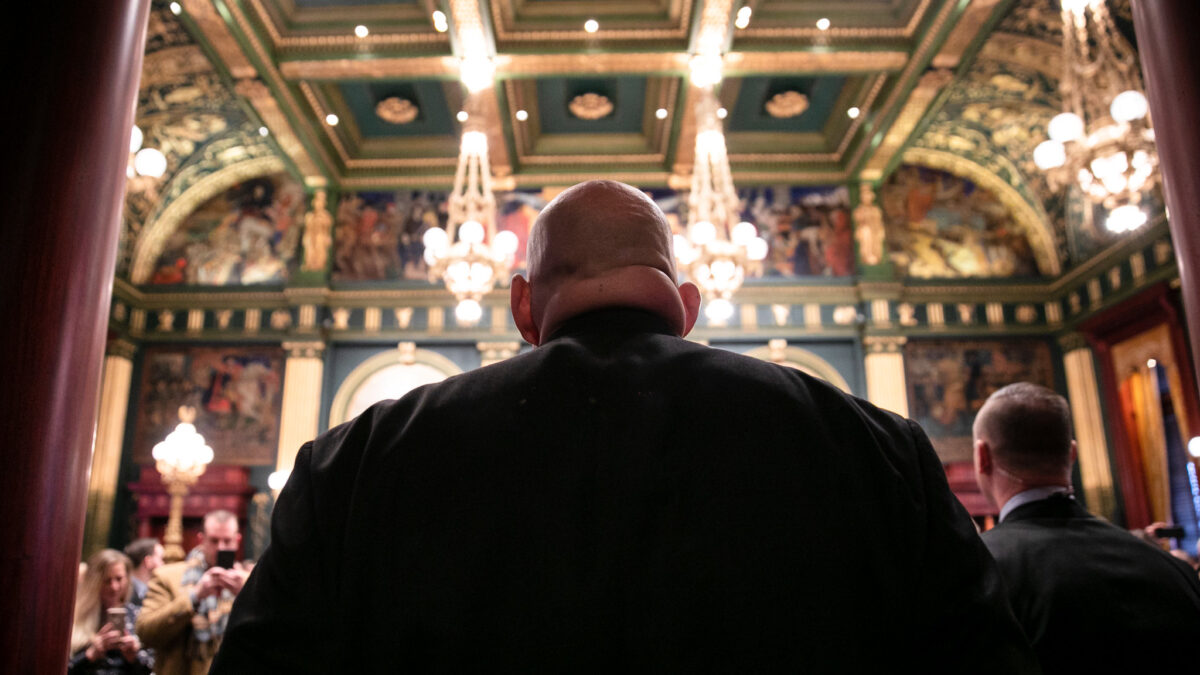“The senator-elect from Pennsylvania is going to bring Carhartt to the Capitol,” The New York Times recently wrote, declaring John Fetterman one of the 93 most stylish people of 2022. Evidently, according to the Times, no one in Washington, D.C., heard of the outerwear company until the career politician, whose lifestyle had been subsidized by his parents well into his adult life, began lumbering around Pennsylvania campaigning for the U.S. Senate.
But the issue at the heart of the matter isn’t the media’s insistence on respecting Fetterman’s “drip.” After all, it’s far more likely that people employed at the Times unironically view the American working class who regularly wear Carhartt attire as sartorial terrorists and blights on their carefully crafted Instagram pages. Instead, the corporate media and the left-wing activists who fill out its ranks mobilized to introduce a visceral, values-based distinction into American politics and subverted the electorate’s expected aesthetic standards, all while continuing to lick the boots of their left-wing paymasters.
These institutionalized media interests, existing solely to advance the goals and narratives of an entrenched leftist regime, have carried water for Fetterman ever since it became clear he was Pennsylvania’s best bet at getting an unhinged leftist in the U.S. Senate. But in Fetterman, they had a unique challenge: How do you convince the masses to vote for a man who doesn’t look, talk, or act like anyone’s idea of what a politician is?
Fetterman very obviously doesn’t look like the typical politician; he’s six-foot-eight, covered in tattoos, and adopted a brand as the “dude” in shorts. And considering that in the current year, “politician” is one of the few careers where what you wear to work actually matters, the Fetter-drip leaves something to be desired. The man himself even previously addressed these concerns.
The media, being aware of Fetterman’s unique fashion sense, worked tirelessly to cover for him by providing the same fawning coverage they do for every leftist, but this time they went into hyperdrive framing what would normally be offputting — his image — as something positive, and worked to redefine it as a regional hallmark that showed how deeply he represented the interests of his constituents. The coverage was meant to distract voters from the fact that Fetterman’s policies were utterly insane while convincing them that a career politician who shows up to work in his sweats and gym shorts could be trusted with power.
If people are more focused on the aesthetics of a race, they will be less concerned about the policies being advanced by candidates. It takes electoral politics to one of its many logical end states — voters make their decisions on something of seemingly existential importance based upon aesthetic signals. Vote for the guy who looks like he might be a plumber, even though he’s rich!
In 2020, as a second senate campaign looked like it was on the horizon for Fetterman, GQ fawned over his sense of style, writing:
Menswear icons are not made overnight. From Paul Newman and Steve McQueen to Pharrell and Kanye West, or more recent members of the canon like Jonah Hill and Shia LaBeouf: these are men who’ve had skin in the game for decades, who inscribe their place in the canon year by year, outfit by outfit.
But once in a while—because this is America, land of opportunity, after all!—comes a man who toils in the background, perhaps content with local celebrity status. And when, or if, history foists him into the spotlight, he ascends to icon status instantly.
Pennsylvania Lieutenant Governor John Fetterman, with his enormous collection of regionally-appropriate Carhartt gear, is just such a man.
The article, which directly compared Fetterman to Davy Crockett — one of the heroes of the Alamo — also made note that Fetterman likes to wear “lime-green neck gators and enormous Dickies button-ups” with his “outwear of choice” being “a navy Carhartt fleece and a black channeled puffer.”
The piece audaciously concludes by saying:
Wherever his ambitions take him, the world is waiting to welcome an official in Dickies shirts and Carhartt pants. Fetterman is that rare thing, a figure we have forgotten in this country, amid preppy aspirations and Trump’s empty-glass tower rhetoric. He is nothing less than an American taste god.
GQ doesn’t want you to think about Fetterman’s politics — those aren’t even a concern, nor should they be. Forget about the fact that for years now, the magazine has been just as, if not more, concerned with political coverage than it has men’s fashion; Fetterman is a leftist, so the corporate media have to cover for him. It’s teleological.
The Times even acknowledged this past May that “style” is the “operative word” in making sense of Fetterman as a political phenomenon. His radicalism is irrelevant; you aren’t supposed to acknowledge it. Just look at how he’s wearing shorts — isn’t that quirky?
Like GQ, its emphasis on Fetterman’s specific wardrobe pieces reads like right-wing satire of legacy media. The Times piece states:
Now the question is how [his manner of dress] will play in the general election and whether, in their quest to succeed, other candidates will follow his lead. If so, it may represent one of the biggest shifts in political communication and subconscious button pushing via dress since female legislators were allowed to go sleeveless in Congress.
After all, not for Mr. Fetterman the bland navy suit, white shirt and red or blue tie that has been de rigueur for the political class for decades. Or not for him most of the time: In 2020 he confirmed via Twitter he had only one suit, a single-breasted dark number, that he wore “for special occasions like Legal Weed, Lurch-themed Halloween pictures, + so they let me in the PA Senate.” (Also, for his official inauguration as lieutenant governor and last month’s primary debate.)
After Fetterman suffered a stroke on the campaign trail, the corporate media’s sycophantic coverage of him intensified as these legacy institutions further exposed themselves to be more obsequious than Pravda in their pursuit to ingratiate themselves among the ruling elite.
New York Magazine wrote a profile of the then-candidate — whom the media had previously billed as the big-bad-rustbelt-dude-in-shorts — titled “The Vulnerability of John Fetterman” with Fetterman’s face on the cover.
The piece proclaimed:
Political reporters were gobsmacked; they’d never seen anyone like him before. Sure, on some level, he was exactly the same as every other senator in Pennsylvania history, a white man. But he wore shorts in January!
It continued by lamenting how Fetterman’s “greatest strength,” his “indestructible guy-ness,” was “jeopardized” and “seized upon by his Republican opponent.”
Sure, it’s fun to make fun of the corporate media when they appear so out of touch that they don’t seem to understand the utility of day-to-day things and suggest that a slovenly slob is stylish. But at the end of the day, those within it still have a significant amount of control over public consciousness and our culture. They have mobilized our system of governance against us before, lest we forget the Russia collusion hoax.
The American political system is already incredibly corrupt, and our political traditions grow evermore perverse. We shouldn’t allow the institutions responsible — like the corporate media — to hollow out our standards as well.








